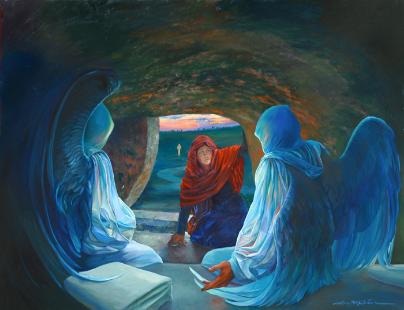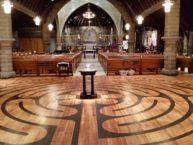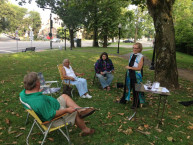 Easter Sunday – April 9, 2023: May God’s words be spoken, may God’s words be heard. Amen.
Easter Sunday – April 9, 2023: May God’s words be spoken, may God’s words be heard. Amen.
Alleluia! Christ is risen!
He is risen indeed! Alleluia!
Dang, that never gets old. And perhaps that is why you are here.
You already know the story – just as with Christmas. And yet, here you are. Now, maybe you came because your parents, grandparents, or spouse “made you.” But let’s be real here – unless you are a child living under your parent’s roof, you have a choice. And the choice you each made was to be here, in person, for this most important day of our faith. And if you are a child, I hope there is a day when you look back and thank those who “dragged” you here to church, even if only as part of the C&E (Christmas and Easter) crowd. Because this proclamation we just made – it changes everything – and has for centuries.
And what we heard today begins with a woman, in a garden, at night.
Mary Magdalene, the only one in all four gospel accounts who is the first to see Jesus – to witness the resurrection – goes to the tomb where the body of Jesus had been laid. And the gospel passage opens with this: “Early on the first day of the week, while it was still dark, Mary Magdalene came to the tomb and saw that the stone had been removed…”
Now there is more to the story – she tells others, they come to take a look. It says they believed, but did not understand scripture, so the only thing they could really believe was the body had been stolen. They left. But Mary remained. Her grief keeping her in darkness even as the break of dawn began to rise above the garden mist. Maybe that is why she then bent in to look in the tomb.
The tomb was the last place the one she loved had been, and it was dark – it matched how she felt. He had been brutally killed, and to add even more pain, she now could not grieve beside his body. Instead of the darkness she expected though, she saw two angels in white who ask “Woman, why are you weeping?” And after she tells them she is looking for her Lord, she turns and sees another asking her the same question “Woman, why are you weeping?” She doesn’t know it is Jesus speaking until he calls her by name. He then tells her not to cling to him, but to tell the others “I have seen the Lord!” This is why Mary Magdalene is known through the centuries as the apostle to the apostles. The first to receive the good news, and the first to preach it to the others.
This is the gospel we heard today. There is a lot to take in, especially with that crazy bit of the beloved disciple and Peter – I mean – what the heck? But there is something we sometimes miss, and it is right at the beginning – “…while it was still dark, Mary Magdalene came to the tomb and saw that the stone had been removed.” While it was still dark.
In the gospel of John, light and dark are featured prominently as metaphors for knowledge & understanding. Nicodemus visits Jesus at night trying to know more about him. Judas leaves the last supper, and the narrative notes that “it was night.” The gospel itself opens with “What has come into being in him was life, and the life was the light of all people. The light shines in the darkness, and the darkness did not overcome it.”
So, it is no coincidence that Mary came to the tomb while it was still dark in this gospel, where the others have her arriving at or after dawn. She did not yet know what was to come, no one did, even though Jesus tried to tell them. Her heart ached with grief, her eyes were filled with tears. The cruelty of the world had cut her to the core. The authors of this gospel wanted us to understand all of that with that simple reference – it was still dark. It was still dark – because no one knew yet the good news.
Today we may feel a lot like Mary. It seems the cruelty of the world has come to our very doorstep with every breaking news story – from natural disasters to the many ways in which we crucify Jesus today – when children are cut down in school by our weapons of war, when people are marginalized or abused because of who they are or how they love, when the ravages of war kill and wound.
If the Johanninan Community that wrote this gospel were writing for the New York Times today, the articles would probably start a lot like something Snoopy types out from the top of his doghouse “It was a dark and stormy night…” For we cannot seem to understand why all this happens, and our despair can have us wondering if the dawn will ever come. We can even begin to feel comfortable in the tomb – it has become so familiar.
And we all have been there at one time or another on a personal level too – with pain known only to each of us, and to those in our close circle – when we too experience betrayal, denial, or death. That is one of the reasons I love our Healing Eucharist that we do on Wednesday in Holy Week. We gather at night to turn our pain over to God – actually writing down what we are feeling and burning them in a fire made from the palms of last year’s Palm Sunday. It is a time of naming the darkness that envelopes our hearts, of being nourished in the Eucharist, and of being anointing with oil for healing.
And this year, at the end of the service, I gave all who attended packets of wildflower seeds. Now, the thing about seeds is that they don’t really look like much do they? Little and seemingly lifeless, we put them into the darkness of the soil and wait in hope that something might happen. And if you looked at a garden in winter and early spring, it wouldn’t seem like anything happened at all with those little things.
Sometimes we can think that about the world or our lives – nothing ever changes – darkness, despair, hate, and death seem to always be. Mary and the other disciples must have felt that way too – having placed their hope in Jesus, and experiencing his arrest and brutal death on the cross. But we know that when it comes to gardens, as the earth warms, and the spring rains come, from the dark soil sprouts new life.
The same is true for us – because of the story we tell today! And it is all right there in that first sentence.
Mary did indeed walk to the tomb at night – yet here’s the part we sometimes miss – the stone was already gone, and so was Jesus! The resurrection had already happened. Jesus didn’t rise from the grave at dawn! It all happened at night!
And that, my friends, is the good news we celebrate – that God’s divine light is at work in the world even when we or others cannot readily see it.
That is our faith – and it is not an easy leap. It runs counter to our senses. It challenges us to see things in a new way.
Yet because of the empty tomb we have hope at the foot of the cross.
We know that light is always present in the darkest of nights, even if cannot yet see it.
We know that love will always overcome hate.
And we know that new life is always possible in the face of death.
Perhaps that is why the resurrection – that empty tomb – is in a garden. Just the place for new life to grow out of the dark soil of the grave.
But here’s the thing about the story of the resurrection we hear today – it didn’t end in the garden.
The empty tomb isn’t the end of the story, just the beginning of the next chapter.
Mary was sent to tell the good news.
And while those boys back in their homes didn’t believe her when she said “I have seen the Lord,” – ‘cause you know, the whole men listening to women bit – it doesn’t change what Jesus asked her to do.
It doesn’t change what Jesus asks us to do today either.
Now this doesn’t mean you need to run out of here to shout “I have seen the Lord!” Though that would be great.
It means that we must seek and serve the risen Christ now.
I mean, we don’t say Christ was alive, right? Do we?
Is that what we proclaim that he was risen?
No! Christ IS alive! And he is calling us by name as he did Mary, that we might be his apostles in the world.
How the heck do we do that?
Well, in a few moments, we will renew our baptismal covenant, and the answer is right there in the vows we make. We commit to “seeking and serveing Christ in all persons, loving our neighbor as ourself, and striving for justice and peace among all peoples, respecting the dignity of every human being.”
That is how we proclaim “I have seen the Lord!” – by living as a people of the resurrection – serving the living Christ in all people.
And a second vow we make is that we will “continue in the apostles’ teaching and fellowship, in the breaking of the bread, and in the prayers.”
We may be the body of Christ, but even he gathered others around him to form a faith community. They in turn formed their own, and so on through the centuries to those who founded this very church in which we now worship.
What we do here on Sundays – every Sunday not just Easter – matters. Being physically present here with one another, being nourished in the real presence of Christ in the Eucharist, that is what we commit to. And it is the garden moment we all need in a world where crosses loom large.
So let us, who today sing that Christ is alive, remember that we are sent by that same Jesus share the good news in word and in deed.
Let us, who shout with joy that Christ is risen, return here each week to be nourished by him in the Eucharist.
That as the sound of our Alleluias fade into the woodwork and stone of this place this night, the truth of the risen Christ will remain in our hearts, and by our service to him in the world, all may come to know the power of God’s great love.
And that, THAT, is truly is something that never, ever, gets old.
Happy Easter everyone!
Amen.
For the audio, click below, or subscribe to our iTunes Sermon Podcast by clicking here (also available on Audible):
The Rev. Diana L. Wilcox
Christ Church in Bloomfield & Glen Ridge
April 16, 2017
Easter Sunday
1st Reading – Acts 10:34-43
2nd Reading – Colossians 3:1-4
Gospel – John 20:1-18




